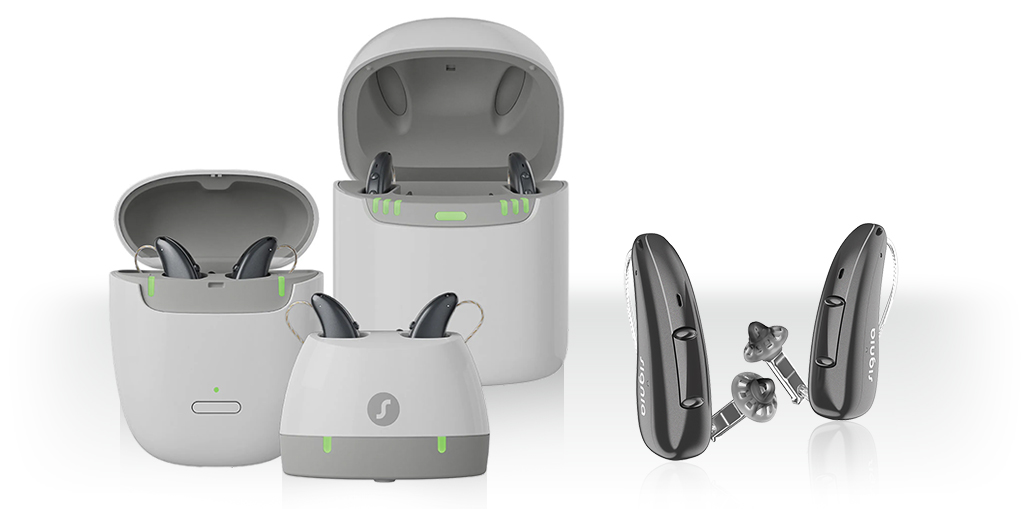If the steps above do not resolve the issue and there is still no sound, it is recommended to take the device to a service center for a thorough check-up.

Rechargeable hearing aids are a user-friendly and convenient technology for the elderly. Examples include the Signia Pure C&G AX (RIC-type hearing aid), Signia Motion C&G X (BTE-type hearing aid), or Bluetooth hearing aids like the Goodhearing R1 and devices from the brand Mimitakara. These are modern and highly convenient solutions for seniors.
However, minor issues may occasionally occur, such as low volume, intermittent sound, or no sound at all. In many cases, these problems do not require immediate servicing, as they can often be easily checked and resolved at home.
Today, Digibionic will walk you through 7 simple steps to troubleshoot and check your rechargeable hearing aid at home.
Check if the battery is fully charged.
Place the hearing aid on the charging dock and observe the indicator light:
Green = Charging / Fully charged
Orange/Red = Battery low / Battery empty
No light = The cable may not be properly connected, or the hearing aid may not be placed correctly on the charger
📝 It’s recommended to charge the hearing aid every night before bed to ensure it’s ready for use the next day.
Check the power button. (Note: Some models do not have a power button and will turn on automatically when removed from the charging dock.)
If the device is off, there will be no sound at all. Try turning it back on to see if the issue is resolved.
Use a dry cloth to clean the metal contact points on the bottom of the hearing aid and inside the charging case. You can also use a small brush (usually included with the device) to gently remove any earwax or dust from the brass contact surfaces on both the charger and the hearing aid.
The small filter or wax guard at the end of the speaker may become clogged, causing no sound to come through. Replace the wax guard included with the device, following the instructions in the manual, or visit a service center for a check-up and replacement.
Check if the cable connecting the device to the earpiece is frayed, bent, or damaged. If you notice any broken or detached wires, you may need to have it repaired at a service center. If the model supports Bluetooth, try resetting the connection with your mobile phone or the device you’re using.
Put on the hearing aid and listen to the surrounding sounds, such as the ticking of a clock or someone speaking. Try gently tapping the device and see if it responds with sound. If the sound is still unclear, you may need to adjust the volume or consult a specialist.
If the steps above do not resolve the issue and there is still no sound, it is recommended to take the device to a service center for a thorough check-up.
If you have followed all the steps and the issue persists, it is recommended to take the device to the service center where it was purchased or contact a hearing aid specialist near your location for assistance.
Regular care and maintenance of hearing aids help extend their lifespan and ensure clear hearing at all times.
Prevents low or intermittent sound
Earwax is the primary cause of low or unclear sound from hearing aids.
Prevents damage from moisture or dust
Moisture from sweat or humid environments can damage the internal circuitry.
Maintains ear health
If the device is dirty, with earwax or mold, it can cause irritation or infections in the ear canal.
Ensures optimal performance
A clean device works consistently, reducing issues like whistling or sound dropouts.
Extends lifespan and reduces repair costs
A well-maintained hearing aid functions better for longer, reducing the need for frequent replacements and repairs.
A hearing aid is like a second ear, and the better you take care of it, the better your hearing will be. Plus, it helps protect your ears from infections.
For Digibionic customers, don’t worry, as we offer comprehensive after-sales services. You can schedule free maintenance every 2 months, including cleaning, replacing earwax filters, ear tips, and sound tubes, as well as fine-tuning the sound settings, all tailored to your needs. We care, we’re experts, and we offer great value!


The latest model Hearing Aid Service Center of 2025. The newest hearing aids with excellent quality and service.
If you’re someone who loves watching TV but feels that the sound isn’t clear enough or needs to turn up the volume so loud
If you’re someone who wants to hear speech clearly, even when you’re far from the speaker or in a noisy environment
Head Office 3,5 ถนนสุทธิสารวินิจฉัย แขวงสามเสนใน เขตพญาไท กรุงเทพมหานคร 10400
เปิดทำการวันจันทร์-วันเสาร์ 09:00-18:00 น.
สำรองคิวล่วงหน้าหากต้องการมาในวันอาทิตย์
copyright © digibionic 2023 all rights reserved
เราใช้คุกกี้เพื่อพัฒนาประสิทธิภาพ และประสบการณ์ที่ดีในการใช้เว็บไซต์ของคุณ คุณสามารถศึกษารายละเอียดได้ที่ นโยบายความเป็นส่วนตัว และสามารถจัดการความเป็นส่วนตัวเองได้ของคุณได้เองโดยคลิกที่ ตั้งค่า